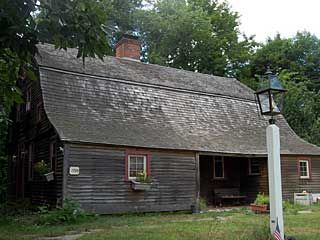The History of Wood Roofing
Ancient Middle Eastern Times
The use of wood began years ago, primarily in Ancient Middle Eastern times. Wood was used to build houses, ships, temples, and buildings. It was highly coveted due to it’s durability and abundance. Wood bark also has a distinct scent, the aroma was used as incense in religious ceremonies and to treat illnesses. Interestingly enough, cedar wood is mentioned over 70 times in the Old Testament of the Bible.
Golden Hall and Five-storied Pagoda of Hōryū-ji, a Buddhist temple in Ikaruga, Nara prefecture, Japan. Oct 2006 by 663highland
Colonial Times
In Colonial times, wood was extremely popular in North America thanks to the abundance of land and lumber. From the architectural styles of French Colonial, Spanish Colonial and Dutch Colonial to Colonial Georgian, Mid-Atlantic Colonial, and German Colonial, wood and wood roofing was used heavily in the foundation, structure, and protection of these buildings.
The National Park Service explains:
“Because trees were plentiful from the earliest settlement days, the use of wood for all aspects of construction is not surprising. Wooden shingles were lightweight, made with simple tools, and easily installed. Wooden shingle roofs were prevalent in the Colonies, while in Europe at the same time, thatch, slate and tile were the prevalent roofing materials.”
In North America, Western Red Cedar wood was pivotal in the development of Native Cultures. It was used in the construction of structures, canoe building, plank houses, and was used in cultural and religious ceremonies. Depending on the region and traditions, local builders used the most common species of tree that was found. Wood shakes were usually split from wood that was regionally available, such as cedar, pine, redwood, Alaskan yellow cedar, eastern white cedar, oak, and cypress. While wooden shingle roofs were prevalent in the Colonies, in Europe at the time, thatch, slate and tile were the more prevalent roofing materials.
18th Century
Dating back to the 18th century, wood shingle surfaces were coated with oils to protect the wood from sun, rain and time. Linseed oil, pine pitch coating and brick dust minerals were used to protect the wood. Wood shingles were also treated with colors for decorative purposes, including gray, red, brown and gray colors. Untreated wood shingles remained light brown and gray in color, which only added to their unique natural appearance.
19th Century
In the 19th century cedar wood shakes and shingles became the primary source of roofing for public buildings and most homes. Many National Park buildings in North America were constructed of cedar with cedar shingle roofing. In the United States for example, white pine was the most used type of wood. In the Southern United States, shingles made of oak and cypress were more common, in the Western United States, redwood and cedar is popular.
Modern Times
Throughout history, the wood from cedar trees has been valued. Wood offers beautiful color, aesthetic appeal, attractive fragrance, and is resistant to insects, temperature, and humidity. Wood shakes are also appreciated for their durability and protection from hail and wind. Cedar shake roofs have the benefit of naturally resisting decay as cedar contains natural oils that prevent decay. Shake roofing is also known for it’s aesthetic aging allure – over time wood transforms from a bright warm color to a more distinguished brown or gray look. Wood shake shingles offer many advantages, their dimensional quality and warm appearance enhances your homes character and look. Because of the variations in nature’s colors, no two shake roofs are the same – all wood shakes vary in thickness, width, and grain pattern – which all contribute to the natural beauty of a structure. Wood roofing shakes are also inherently energy efficient and can be recycled into mulch and chips after use.
While wood roofing has it’s downfalls such as organic material degradation over time and being an extreme fire risk, wood roofing has never really gone out of style. Homeowners in passing generations have continued to favor the unique appearance that only wood can provide. From the Victorian era to the Colonial Revival era in the following century, one movement after another has only reaffirmed the staying power of wood and wood roofing.
Introducing a better alternative - Composite Synthetic Roofing Materials
With advancements in technology, consumers and the building industry began looking for alternatives to mimic the beautiful wood look of natural cedar shake. Not only is wood a severe fire risk for homeowners in mountain communities and high fire danger areas, but homeowners nowadays want the beautiful wood look in a low maintenance material that is fire resistant. In comes CeDUR. CeDUR is an extremely lightweight, fire resistant synthetic composite roofing material that mimics the beautiful wood look of 3/4” inch heavy hand split cedar shakes.

